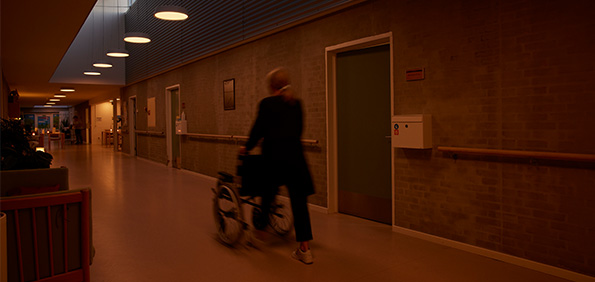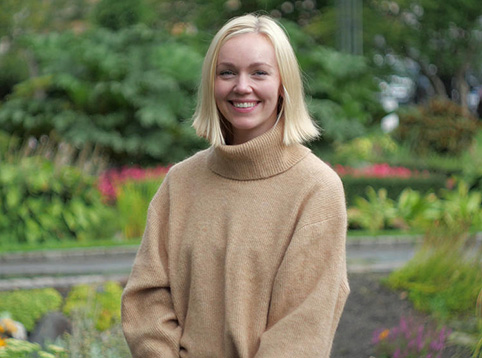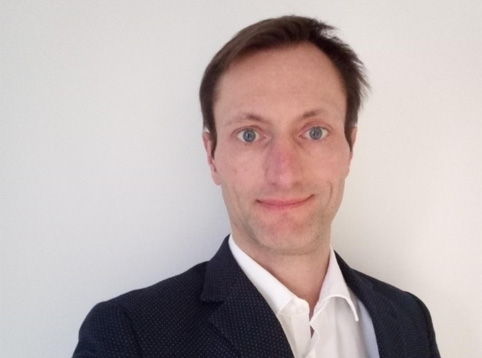Last year, five companies from Switzerland, Poland, and Denmark joined forces together with a Danish nursing home to improve lighting conditions in European nursing homes. The project is funded by the EU program AAL - "Ageing Well in the Digital World" and is based on the recognized knowledge that light controls human circadian rhythm and is crucial for our physical and mental health.
The project is called PerCiLight and is built upon the evidence-based circadian lighting, Chroma Zenit, taking into account the personal needs of older citizens to enhance their health and well-being. Read more about the project here.
Simultaneously, two major scientific studies have been initiated to analyze and document the effect of the lighting at Bauneparken nursing home in Hillerød municipality, where the PerCiLight solution is being tested in 22 apartments. The studies have different focus areas and investigate various aspects of the project.

Personalized Circadian Lighting for Nursing Home Residents
Through research and several major studies, it has been proven that light plays a crucial role in human health. Furthermore, research has documented the beneficial health effects of Chroma Zenit circadian lighting for nursing home residents.
With the PerCiLight project, we are taking the technology to the next level by exploring the possibilities of individually adjusting the light and thus personalizing the light that nursing home residents are exposed to throughout the day. The interesting aspect is to understand the impact it has on residents' health and quality of life when using lighting that is much more personalized. This is being investigated in one of the scientific field studies led by Professor of Clinical Psychology Elisabeth Flo-Groeneboom from the University of Bergen (UiB).
This study aims to examine how light can improve the mental health and sleep of older individuals, both with and without dementia, and determine the additional value of personalized lighting. Elisabeth Flo-Groeneboom, who has previously studied the effect of light on people with dementia, has high expectations for the project as we now have the technology to offer personalized lighting. This study will provide valuable insights into what can be achieved with advanced lighting technology. She explains:
— We have reached a point where we actually have the technology available that can be personalized, is flexible, and is adaptable. Therefore, it will be extremely interesting to see how it affects the nursing home residents. Light is not just light. Research shows that the timing of the right type of light and darkness at the right time is crucial for our circadian rhythm and sleep. Now we have taken the technology to the next level and can actively use it in the demanding care environment.
In the scientific study, Elisabeth and her team are examining several different hypotheses, such as the effect of individualized light on sleep, depression, and overall mental health. The data collection has just begun and consists of multiple phases. First, an investigation is conducted with Bauneparken having normal lighting settings, and later a study is conducted once the intervention is implemented. Additionally, they take into account the seasons and natural light in the study and therefore conduct follow-up studies throughout the year.
The study includes a group of residents who receive the light intervention in their apartments and common areas and a corresponding control group who do not have the light intervention in their apartments.
The study of Bauneparken residents would not be possible without the support of the staff and management from the beginning. Elisabeth explains: —I think Bauneparken is a wonderful nursing home with knowledgeable and educated leadership and staff. They are very open to the project and interested in new knowledge, actively seeking it in close collaboration with us during data collection. I truly applaud the nursing home for their genuine interest, motivation, and expertise in the way they have approached the project.
Effect and Application of New Technology Among Nursing Home Staff
In parallel with the study focusing on the elderly residents in nursing homes, it is also interesting to examine the care staff who typically work at the nursing home for many years, with shifts at all times of the day. Their work takes place in the environment where the light intervention is used, and therefore, they are also exposed to circadian lighting. But what effect does it have on the staff, and what difference does it make that the lighting is individualized? How does it support them in their work? At the same time, the staff is the group that needs to operate the lighting and the new technology. From the beginning, the staff has been involved in the development of the user interface as part of the innovation collaboration, so how does it affect technology acceptance?
All of this is something that Thomas Bjørner investigates in his scientific study. Thomas is head of the Media Innovation & Game Research unit at Aalborg University. His mission is to focus on the staff, as they are rarely the main focus in research.
— The purpose of our study is twofold. On the one hand, we look at the well-being of the employees and whether light intervention improves their quality of life. On the other hand, we examine technology acceptance, user involvement, and the usability of the new innovative technology, says Thomas Bjørner.
The centerpiece of the study is a trinity between users, technology, and context. The technology is personalized and individualized circadian lighting developed to support the daily lives of the elderly in nursing homes, with control options for the staff. The users are the staff members. They vary in terms of experience, age, roles, education, and the time of day they work. Therefore, the context includes both the different situations where the lighting is used and who the users of the technology are.
An important part of the PerCiLight project is the involvement of users in the process from the beginning. Thomas Bjørner highlights this as a major strength and the foundation for successful implementation and technology acceptance. —It is essential to examine how the staff uses the technology and implements the method along the way. That way, we capture as much as possible that can be adjusted continuously instead of making major changes at the end, says Thomas.
— We need to listen much more to what users have to say along the way, so that we can better understand how users comprehend the system and use it, Thomas continues. He also emphasizes the importance of training staff in operating the lighting and facilitating its use in general.
Just like in the parallel study, Thomas Bjørner and his team begin data collection, which includes both questionnaires and interviews. It is important to understand in data collection that light and the experience of light can be difficult to articulate, and people have different preferences for light settings. All of this is carefully planned in the study to cover all aspects and ultimately be able to answer the indicators and hypotheses put forth in the project.
Over the coming period, both studies will continue to work on data collection and analysis. It will be interesting to see the results of these scientific studies. Likewise, we will continue our work in the PerCiLight project and innovation in lighting for elderly care. Follow our website and LinkedIn for updates on the project and studies.
About Elisabeth Flo-Groeneboom
Elisabeth is a psychologist and professor at the Department of Clinical Psychology, Faculty of Psychology, University of Bergen (UiB), and the head of the Human Light Lab and Bergen Research Group for Innovation, Growth, Health, and Technology (BRIGHT). Today, her research and teaching focus on MSc and PhD courses on non-pharmacological interventions, sleep and circadian rhythms, mental health challenges throughout the lifespan, and functioning in older adults and individuals with dementia. (Source: https://www.uib.no/en/persons/Elisabeth.Flo-Groeneboom)

About Thomas Bjørner
Thomas Bjørner is the head of the Media Innovation & Game Research unit at Aalborg University. Thomas' main scientific competencies lie in user evaluations, qualitative and mixed methods in technology-related projects. In addition to methodological advancements in user evaluations, technology acceptance, interviews, observations, and field studies/ethnography, his research also focuses on the characterization of technology use in different contexts. One of the purposes of Thomas Bjørner's research is to emphasize the use of qualitative methods with increased validity and reliability in technology-related projects. (Source: https://vbn.aau.dk/en/persons/109009)


